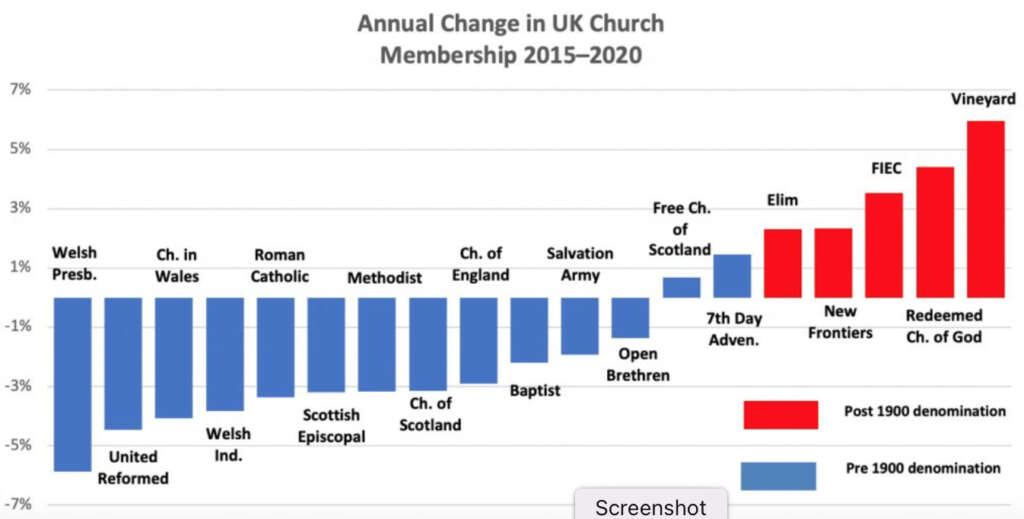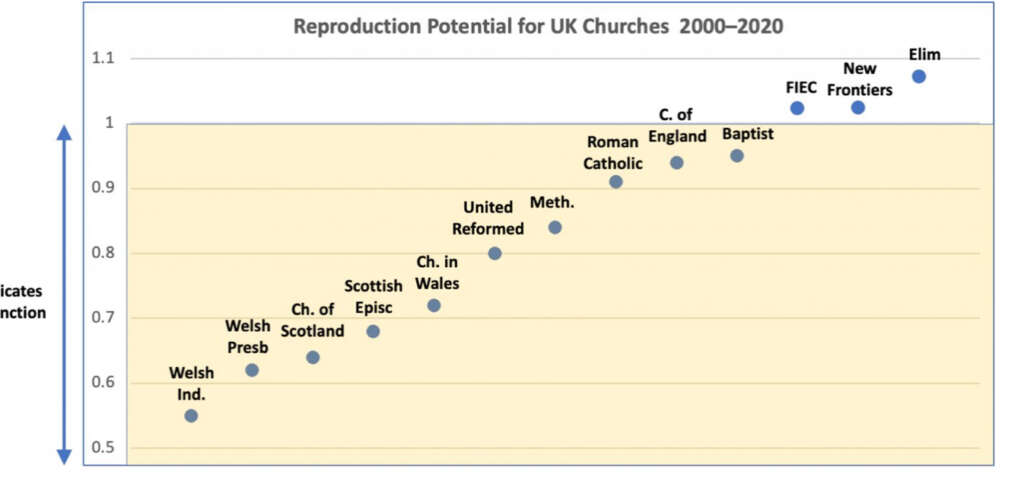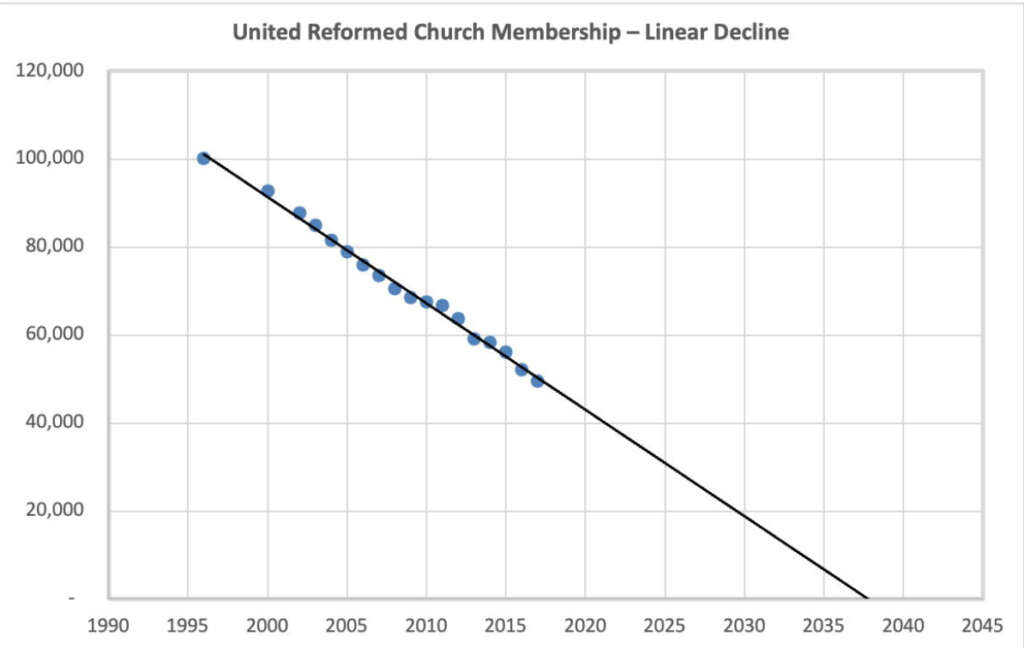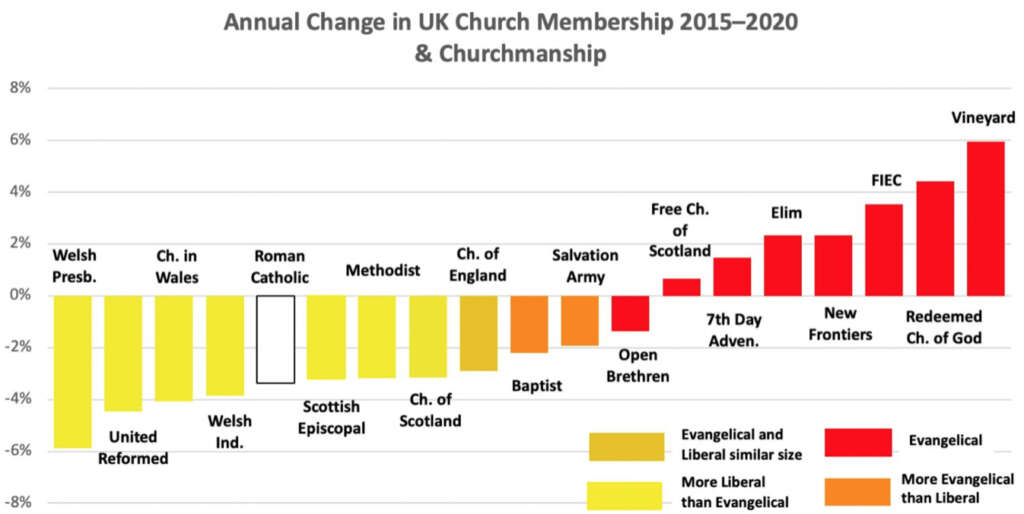There is a definite pattern in which church networks or denominations are declining or growing in the United Kingdom according to statistician John Hayward, a retired university maths lecturer.
His paper has been covered by The Times and reproduced by Christian websites like Anglican.ink.
Some churches are growing numerically in the UK, Hayward finds.
He has used the last five years of statistics to calculate the growth rate for churches. He finds that the Free Church of Scotland (Presbyterian) is growing slowly at less than 1 per cent a year, and the Vineyard network (a pentecostal network) is growing the fastest at 6 per cent a year.
Most of the churches founded before 1900 are declining – United Reformed at more than 4 per cent and the Church of England and Methodists at about 3 per cent a year.

“Both decline and growth rates have stayed constant over many decades,” Hayward writes. “I could have presented a similar chart 20 years ago! The main factor in church decline is the lack of conversions. These churches then get older, and their losses get worse due to higher death rates. Why have the declining churches been unable to increase conversions? How have the growing churches been able to sustain conversions?”
It is about enthusiasm
We have become used to the statistical language of an “R” rate during Covid. Hayward uses membership numbers to calculate the “R” rate for churches.
“For churches, I call it the ‘Reproduction Potential’. If this number is less than one, enthusiasts fail to reproduce themselves, conversions are too weak and the church dies out (the shaded region, figure 2). If the reproduction potential is greater than one, conversions are strong enough to counter losses and the church may grow.”

This graph is based on membership stats from 2000 to 2020.
How many people get converted depends on what he calls the “Limited Enthusiasm Model”. To stretch the Covid analogy, this indicates how many Christians are infectious spreaders of the good news.
“Three churches are increasing their numbers of enthusiasts: FIEC [Fellowship of Independent Evangelical Churches, conservative evangelicals [similar to the Australian group of the same name], Newfrontiers [Pentecostal] and the Elim Pentecostal Church,” Hayward notes. “Although their R numbers are only just over one, that is typical for social diffusion. If they maintain this potential to convert, they could reach five times their current number by the end of the century. But they would have to keep this value for 80 years. Quite a challenge!”
Will some churches cease to exist?
Hayward predicts most pre-1900 churches are in big trouble and headed for extinction. He sees the Baptists and the Church of England as the best placed to survive in this group, but with significantly reduced numbers.
He believes it is possible to predict extinction dates for one group of churches: those which are ageing.
“Membership data for ageing churches follow a downward straight line. [The graph below] shows a typical straight-line decline, predicting the United Reformed Church will become extinct by 2038.

Churches with an R number less than one have time to turn around before extinction. Hayward suggests urgent prayer for revival. The Baptists and Open Brethren have until the end of the century. Catholics and the Church of England until 2060 or so.
The flavour of the church affects decline and growth
According to Hayward’s stats, the evangelical denominations and networks are more likely to grow, and more liberal/progressive ones decline.

All the evangelical groups in Hayward’s lists of denominations and networks are growing, bar the brethren. Mixed (liberal/progressive and evangelical) and liberal/progressive churches are declining. In the graph, he has analysed the relative amount of evangelical presence in the mixed churches, and there appears to be a connection between growth and decline.
Hayward believes that God’s blessing may shift from older denominations to fresher proclaimers of the gospel.
“These products of the Reformation and Puritan times have run their course. They have fulfilled God’s purposes and are no longer part of his plan. The Church of England will cease to be a national church, and the Churches of Scotland and Wales will disappear by the middle of this century. Instead, God will work through the next cycle of denominations – Pentecostal and evangelical ones – picking up the pieces left by the extinct historic churches.”
Email This Story
Why not send this to a friend?



